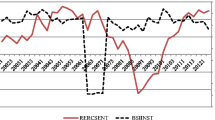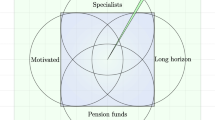Abstract
This study examines whether institutional investors exhibit herding behavior by property type in real estate investment trusts (REITs). Our analysis of changes in institutional portfolio holdings indicates strong evidence of this behavior. We analyze the autocorrelation in aggregate institutional demand, and find that most of it is driven by institutional investors following the trades of others. This herding occurs at the property-type level, and not at the individual firm level. Although momentum trading explains a small amount of this herding, institutional property-type demand is more strongly associated with lagged demand than lagged returns. The results suggest that correlated information signals drive herding in REITs. In addition, we examine the extent to which herding in REIT property types affects price performance in the private real estate market. We find that information transmission resulting from institutional herding in REITs occurs faster in public real estate markets than in private markets.
Similar content being viewed by others
Notes
1 Derwall, Huij, Brounen, and Marquering (2009) suggest that the conventional multi-factor models do not fully explain the cross-section of REIT returns, and find that a REIT momentum factor provides additional explanatory power. Our study is at the property-type level, and our results in Table 6 show that a momentum-based strategy does not yield abnormal returns. As a result, we are comfortable with interpreting the alphas from three-factor models.
2 Quarterly market, size, and value factors were obtained from Ken French’s web site.
3 National Council of Real Estate Investment Fiduciaries
4 These data are obtained at https://www.ncreif.org/tbi-returns.aspx.
References
Anderson, R.I., Guirguis, H., & Bony, V. (2012). The impact of switching regimes and monetary shocks: An empirical analysis of REITs. Journal of Real Estate Research, 34, 157–181.
Chan, S., Leung, W., & Wang, K. (1998). Institutional investment in REITs: Evidence and Implications. Journal of Real Estate Research, 16, 357–374.
Chang, E.C., Cheng, J.W., & Khorana, A. (2000). An examination of herd behavior in equity markets: An international perspective. Journal of Banking and Finance, 24, 1651–1679.
Chiang, K. (2010). On the comovement of REIT prices. Journal of Real Estate Research, 32, 187–199.
Choi, N., & Sias, R. (2009). Institutional industry herding. Journal of Financial Economics, 94, 469–491.
Derwall, J., Huij, J., Brounen, D., & Marquering, W. (2009). REIT momentum and the performance of real estate mutual funds. Financial Analyst Journal, 65, 24–34.
Fama, E., & French, K. (1993). Common risk factors in the returns on stocks and bonds. Journal of Financial Economics, 33, 3–56.
Gutierrez, R., & Kelley, E. (2009). Institutional herding and future stock returns: Working paper.
Gyourko, J., & Nelling, E. (1996). Systematic risk and diversification in the equity REIT market. Real Estate Economics, 24, 493–515.
Lakonishok, J., Shleifer, A., & Vishny, R. (1992). The impact of institutional trading on stock prices. Journal of Financial Economics, 32, 23–43.
Li, J., Mooradian, R., & Yang, S. (2009). The information content of the NCREIF index. Journal of Real Estate Research, 31, 93–116.
Ling, D., & Naranjo, A. (2003). The dynamics of REIT capital flows and returns. Real Estate Economics, 31, 405–434.
Ling, D., & Naranjo, A. (2006). Dedicated REIT mutual fund flows and REIT performance. Journal of Real Estate Finance and Economics, 32, 409–433.
Ling, D., & Naranjo, A. (2015). Returns and information transmission dynamics in public and private real estate markets. Real Estate Economics, 43, 163–208.
Moskowitz, T., & Grinblatt, M. (1999). Do industries explain momentum?. Journal of Finance, 54, 1249–1290.
Newey, W., & West, K. (1987). A simple, positive, semi-definite, heteroskedasticity and autocorrelation consistent covariance matrix. Econometrica, 55, 703–708.
Nofsinger, J., & Sias, R. (1999). Herding and feedback trading by institutional and individual investors. Journal of Finance, 54, 2263–2295.
Patterson, G. (2009). The relationship between REIT propery types and economic risk factors. Academy of Business Disciplines Journal, 1, 19–28.
Ro, S., & Gallimore, P. (2014). Real estate mutual funds: herding, momentum trading and performance. Real Estate Economics, 42, 190–222.
Shiller, R. (2005). Irrational exuberance: Princeton University Press.
Sias, R. (2004). Institutional herding. Review of Financial Studies, 17, 165–206.
Sias, R., Starks, L., & Titman, S. (2006). Changes in institutional ownership and stock returns: Assessment and methodology. Journal of Business, 79, 2869–2910.
Wermers, R. (1999). Mutual fund trading and the impact on stock prices. Journal of Finance, 54, 581–622.
Yunus, N., Hansz, A., & Kennedy, P. (2012). Dynamic interactions between private and public real estate markets: Some international evidence. Journal of Real Estate Finance and Economics, 45, 1021–1040.
Zhou, J., & Anderson, R.I. (2012). Extreme risk measures for international REIT markets. Journal of Real Estate Finance and Economics, 45, 152–170.
Zhou, J., & Anderson, R.I. (2013). An empirical investigation of herding behavior in the U.S. REIT market. Journal of Real Estate Finance and Economics, 47, 83–108.
Acknowledgments
We thank Kent Baker, Nicole Choi, Benjamin Scheick, an anonymous referee, as well as seminar participants at the Southern Finance Association 2013 meeting, the Financial Management Association 2014 meeting, and the AREUEA 2016 meeting for their helpful comments and suggestions
Author information
Authors and Affiliations
Corresponding author
Rights and permissions
About this article
Cite this article
Lantushenko, V., Nelling, E. Institutional Property-Type Herding in Real Estate Investment Trusts. J Real Estate Finan Econ 54, 459–481 (2017). https://doi.org/10.1007/s11146-016-9553-4
Published:
Issue Date:
DOI: https://doi.org/10.1007/s11146-016-9553-4




